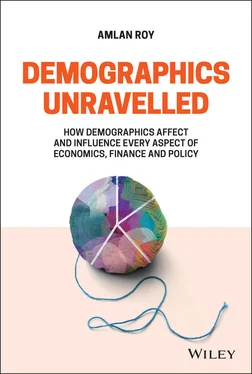6 Retirement and pensions: This chapter highlights the importance of pension institutions amongst global financial institutions and investors. It presents a history of retirement and pensions, pension investment trends, issues facing pension funds, and design of pension systems. Issues underlying strategic and dynamic asset allocation for pensions are discussed, as are the implications of funding for corporate pension funds. The behaviour of the “new giants” (pension funds) is considered important by policymakers such as central banks and treasury departments for the well-being of citizens as well as potential contributors to global systemic risks. The rise of defined contribution plans where participants bear the risk is not without its own issues and has led to the origin of hybrid pension systems. The chapter highlights issues for the collective world of pensions in dealing with the changing new world by adopting changes to mindsets, tools, and asset allocation. It is noted that the governance and management of pension funds is as important as the investment returns from an efficiency and comprehensiveness perspective.
7 Gender, human capital, governance, and quality of life: This chapter extends the focus and objective of individuals and households as well as collectively of institutions beyond monetary and pecuniary values. The extension beyond individual utility to social welfare functions and the human development index and happiness scores is essential for a world where income equality, gender equality, climate change, and corruption are serious concerns. The chapter discusses United Nations sustainable development goals (SDGs), transparency, national governance indicators, and gender scores to assess progress on a sustainable quality of life in a world where Millennials and younger generations care about the environment, equality, sustainability, fairness, and the “means more than just the ends”. We note that quality of life, climate change, and happiness are considered important for a better world and should be monitored.
8 Summary and conclusions: A broader and deeper understanding of demographics is core to creating a better economic and investment environment for multiple generations in an ageing world. Healthy life expectancy with adequate retirement savings is essential for a responsible, sustainable future. Globalization, technology, geopolitics, and politics will interact to influence future consumer and worker behaviour.
Throughout the chapters, all the notes and references have been collected and presented at the end of the book, separated by each chapter. The References are an essential part of this book as I connect references from various different disciplines in the Notes section.
1 1. Peter Drucker pioneered management thinking in many different unorthodox directions and is considered the guru of all pension gurus by many experts, including Keith Ambachtsheer.
2 2. Aldous Huxley's Brave New World (1926) posed many challenges rooted in the basics of demographics.
This chapter introduces and amplifies my broader and deeper perspective of demographics. It presents the layout and chapter sequence with a few sentences on the highlights, including key issues discussed, major take-aways, and challenges to the conventional perspective. It should encourage some readers to go to specific chapters for a deeper dive if they wished to read outside of the sequenced layout of the book.
This book summarises my views and research from a new angle on the subject area of demographics. When I first embarked on the initial stages of my research in this area in the millennium year 2000, I often heard interpretations of demographics related to age, youth, numbers of old, and numbers of very old. My inquisitiveness led me to delve deeper into the subject area to the etymology (word origin) of the term demographics . Its Greek origins stem from demos , which means “people”, and graphos , which means “characteristics”. My mind questioned the fact that if demographics pertained to people characteristics, how are the people characteristics within the subjects of economics and largely restricted to age only or the number of people only? As geography a macroeconomist, my view of “people characteristics” was, importantly, “people as consumers consuming goods and services” and also “people as workers producing goods and services”. This broader definition is not dependent only on age or numbers of young people.
1.1 Recasting Demographics
Broadening this definition of demographics then naturally extends to all the people in the world who are consumers, ranging from the newborn baby to the oldest centenarian, consuming the entire universe of goods and services. The aggregate consumption by individuals in an economy, which is referred to as private consumption expenditures , accounts for the largest share of GDP by expenditures. People's consumption of goods and services is a dominant component of national and global economic activity. A large segment of people in the population possess another characteristic: that of a worker contributing labour toward the production of goods and services, which in aggregate also leads to GDP. Thus, people are the core of any economy, and their salient features are those as consumers and workers—a far more important economic classification than that based on age or numbers of young or numbers of old. This paradigm encompasses the fact that consumer and worker behaviours are more relevant than their mere numbers or their age.
One of the world's greatest management gurus, Peter F. Drucker, had the following to say on the subject “Demographics is the single most important factor that nobody pays attention to, and when they do pay attention, they miss the point” 1 , 2 . This important insight by Drucker resonates with the broader interpretation of demographics that I have adopted and have been popularising for the last couple of decades in my reports, speeches, and discussions.
My first criticism was that conventional approaches to demographics by historians, market commentators, and popular writers were narrowly based on “age and numbers”. There was another popular misconception of demographics (related to the former narrow view) that it was “predictable”. This was based on counting people of certain age: say, if the number of 35-year-olds in a country in 2000 was X million people, then it could be said that the number of 45-year-olds in 2010 would be close to X million adjusted for certain mortality factors. The likelihood that most 35-year-olds would live to be 45-year-olds is close to 1 in most countries of the world. This notion of forward extrapolating the number of people of a given age few years ahead with near certainty or predictability 3 to evaluate their demands is incomplete. However, being Druckerian in spirit, I believe that this popular conception also misses the point by focusing on numbers of people and how many of them are expected to live T-periods ahead in the future (10, 15, 20, etc.). The more important point is not just counting the mere numbers of 45-year-olds 10 years later but rather how different they are as consumers and also as workers than the current 45-year-olds. It is therefore the behaviour of consumers and workers 10 years later that is more unpredictable, interesting, and relevant from an economic and business perspective.
The behaviour of consumers depends on preferences towards consuming today vs. saving for later, also called the discount factor by economists (related to the degree of impatience that an individual consumer displays), and the preference towards risk, called the degree of risk aversion . Dynamic models of consumption and asset pricing in the microeconomics as well as macroeconomics literature build on these two preference parameters. Consumption by people as individuals and in the aggregate also depends on the universe of goods and services they could potentially consume. Consumers in the 1980s didn't have access to the same smartphones (iPhones, Samsung, etc.), web and internet services, and online ordering as consumers of the 2000s or consumers in 2010 and 2020. Technological advances and product innovations have dramatically altered the consumption opportunity set available to individual consumers across all countries in the world, not just in the advanced, rich countries. Globalisation has extended access and availability to consumers in the poorest countries, too 4 .
Читать дальше












